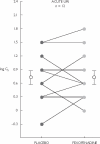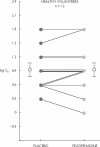Effect of the second-generation antihistamine, fexofenadine, on cough reflex sensitivity and pulmonary function
- PMID: 14651723
- PMCID: PMC1884387
- DOI: 10.1046/j.1365-2125.2003.01902.x
Effect of the second-generation antihistamine, fexofenadine, on cough reflex sensitivity and pulmonary function
Abstract
Aims: Current guidelines recommend the use of first-generation antihistamines for the treatment of cough due to rhinitis/postnasal drip syndrome. The antitussive activity of the second-generation antihistamine, fexofenadine, has not been investigated. Therefore, we evaluated the effect of fexofenadine on capsaicin-induced cough in healthy volunteers and in subjects with acute viral upper respiratory tract infection (URI).
Methods: Twelve healthy volunteers and 12 subjects with URI underwent pulmonary function testing and capsaicin cough challenge on two separate days, 2 h after ingesting 180 mg fexofenadine or matched placebo. Subjects inhaled single, vital-capacity breaths of capsaicin aerosol, administered in incremental doubling concentrations, until the concentration inducing five or more coughs (C5) was determined.
Results: In both subject groups, C5 was not significantly different after fexofenadine compared to placebo. In subjects with URI, pulmonary function studies were also similar. In healthy volunteers, however, FEV1 and FEF(25-75), pulmonary function parameters reflecting the degree of airway dilatation, were significantly increased after fexofenadine. Mean (95% CI) values for FEV1(L) after fexofenadine and placebo were 3.16 (2.77, 3.55) and 3.08 (2.69, 3.47), respectively (P = 0.017). Mean values for FEF(25-75)(L/s) were 3.49 (3.10, 3.88) and 3.26 (2.79, 3.72), respectively (P = 0.029).
Conclusions: Fexofenadine demonstrated no antitussive activity against capsaicin-induced cough in healthy volunteers and subjects with URI. The ineffectiveness of fexofenadine in suppressing cough probably reflects the lack of anticholinergic activity and central nervous system penetrance that is characteristic of first-generation antihistamines. The mild bronchodilation induced by fexofenadine in healthy volunteers is of unclear clinical significance and requires further investigation.
Figures


References
-
- Schappert SM. Ambulatory care visits to physician offices, hospital outpatient departments, and emergency departments: United States, 1995. Vital Health Stat. 1997;0:1–38. - PubMed
-
- Irwin RS, Curley FJ, French CL. Chronic cough. The spectrum and frequency of causes, key components of the diagnostic evaluation, and outcome of specific therapy. Am Rev Respir Dis. 1990;141:640–647. - PubMed
-
- Pratter MR, Bartter T, Akers S, DuBois J. An algorithmic approach to chronic cough. Ann Intern Med. 1993;119:977–983. - PubMed
-
- Irwin RS, Boulet L-P, Cloutier MM, et al. Managing cough as a defense mechanism and as a symptom. A consensus panel report of the American College of Chest Physicians. Chest. 1998;114(Suppl):133S–181S. - PubMed
Publication types
MeSH terms
Substances
LinkOut - more resources
Full Text Sources
Medical
Miscellaneous

